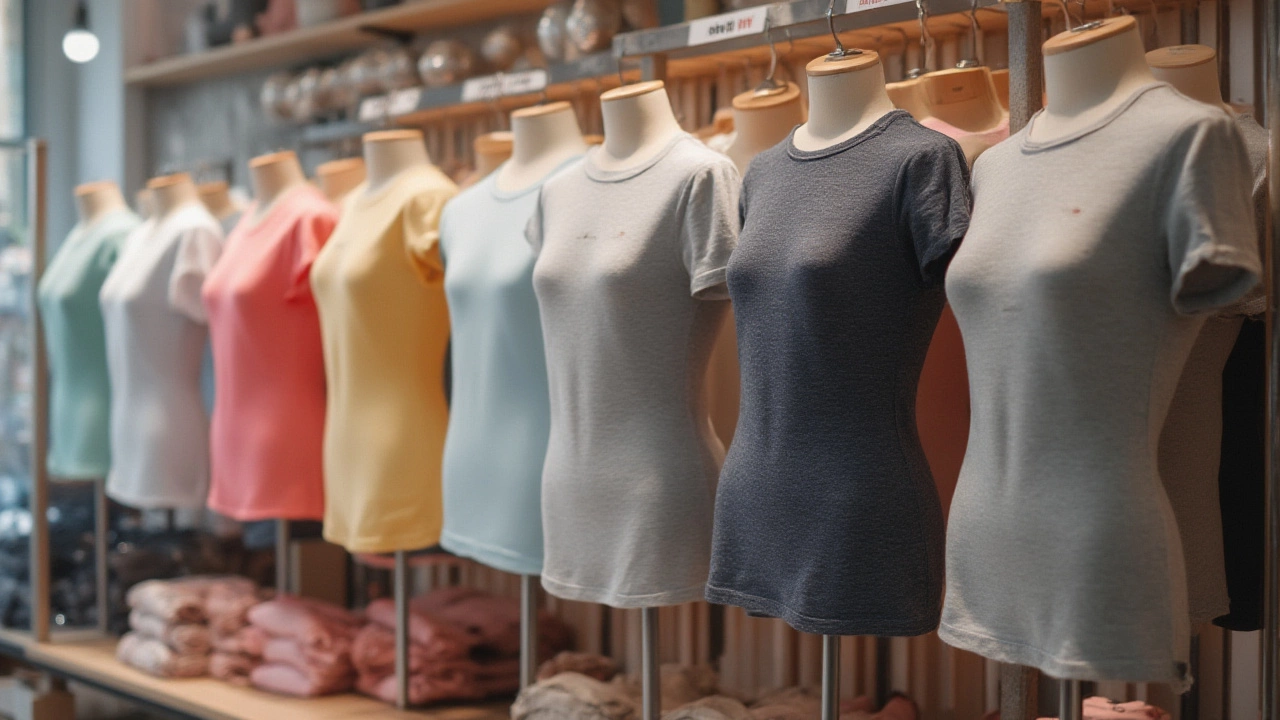You’ve seen them on athletes showing off their hard-earned muscles, at the gym hugging every curve, or just out and about looking way more put-together than the average loose tee could ever dream of. Those tight t-shirts? There’s way more to them than you’d think. Sure, they’re snug, but they’ve also got a lineup of names, styles, and materials that have changed the way people dress and feel.
What Are Tight T-Shirts Called? The Real Names Behind the Trend
Most people just say “tight t-shirt” and call it a day. But walk into your favorite clothing store or shop online, and you’ll quickly get hit with a parade of options that sound fancier: “fitted tee,” “slim fit t-shirt,” “muscle fit tee,” and “compression shirt” are just a handful. Each one actually means something a bit different, so knowing the lingo helps avoid getting a shirt so snug you can barely breathe, or one that just doesn’t flatter the way you want.
Let’s break it down:
- Tight t-shirts: A catch-all phrase, but usually means a shirt that sits close to the body all the way around the chest, torso, and arms.
- Fitted/ Tailored fit: A lot of brands use “fitted” or “tailored fit” for shirts that gently follow your body’s shape, with enough room to move but no loose fabric flapping around. You’ll see this in places like Uniqlo, H&M, and even most big-box chain stores.
- Slim fit: Slim fit leans a little tighter, especially in the sleeves and midsection. Not painted-on, but definitely made for someone who likes showing some shape.
- Muscle fit: Here we’re talking about shirts cut with extra room in the chest, shoulders, and arms, but tighter through the waist. These are big at shops like ASOS, BoohooMAN, or specialty gymwear labels, catering to people who lift or want to fake it.
- Compression: These are the ultra-snug, almost second-skin athletic tops you’ll find in sports stores. Think Nike Pro, Under Armour, or Adidas. Made to reduce muscle fatigue and wick sweat during workouts.
- Body fit / Body-hugging: Some European brands throw in labels like “body fit” that just underline the shirt’s close cut through every part, usually with some stretch for comfort.
Sounds like marketing, but those differences matter. Not every tight shirt is built for the same reasons. If you’re shopping, checking the brand’s size guide (and even reviews from real buyers) makes all the difference in getting a flattering fit that doesn’t cut off circulation.

Why Tight T-Shirts? How Style, Technology, and Confidence Collide
Tight t-shirts might seem like a trend from the gym crowd or college kids, but the roots go deeper than you’d expect. Back in the 1950s, stars like Marlon Brando and James Dean rocked white tees so snug they became status symbols. Tom Hardy or Chris Hemsworth throw one on now and suddenly social media’s on fire, but tech has evolved those shirts way past anything from your granddad’s era.
First off, you’ll notice that most fitted shirts today have some kind of stretch in them. Cotton blended with a juice of elastane (spandex) or polyester lets these tees move with you instead of against you. No more fear of raising your arms and hearing a rip. Modern examples are everywhere: Nike’s Dri-FIT, Under Armour HeatGear, and even classic Levi’s make slim tees that feel like a cloud but snap back after every wash.
But it’s not just about comfort. According to a 2024 consumer survey by Statista, over 37% of men aged 18–35 say they prefer clothes that “accentuate their physique.” Wearing a slim or muscle fit tee answers that, showing off what you’ve built (or just giving the illusion that you’ve hit the gym), while looking put-together. And that’s really the hook—tight shirts aren’t just for bodybuilders. Anyone looking to sharpen up their look without fuss can grab a fitted tee, toss on a jacket, and instantly step up the style.
Don’t sleep on the technology. Moisture-wicking, anti-odor, anti-bacterial—you’ll find these words on tags from athletic brands. Not just hype, either. Studies have shown shirts with anti-microbial silver threads help reduce odor after a sweaty commute or workout. Plus, tighter fits mean less bunching under gear, so bikers and runners aren’t spending time adjusting their clothes during long sessions.
Women’s fashion joined the party, too. Brands like Zara, Gymshark, and Alphalete have all launched lines with ultra-fitted tees, mixing stretch cotton with mesh for breathability and a silhouette that moves with you. And there’s a twist: some “baby tees”—think Y2K style—are actually just kids’ shirts sized up for adults, so if you’re hunting for that cropped, tight look, the fashion world is ready to keep you supplied.
So, who’s the winner in the fit game? It comes down to your body (and confidence). Don’t be afraid to size up or down, either. Most tight shirt brands expect you to experiment. Try before you buy, or at least keep the tags until you’re sure. Remember, the main rule is you should be able to move, bend, and breathe without feeling like you’re being wrapped up for shipping.
Take a look at how types of tight t-shirts are used today in different contexts:
| Fit Type | Main Use | Key Fabric Feature | Popular Brands |
|---|---|---|---|
| Muscle Fit | Casual & Gym | Stretch Cotton | BoohooMAN, ASOS, Gymshark |
| Compression | PerformanceSports | Moisture-wicking Synthetic | Nike, Under Armour, Adidas |
| Slim/Tailored Fit | Smart Casual | Soft Jersey Cotton Blend | Uniqlo, H&M, Banana Republic |
| Body Fit | Everyday/Streetwear | Elastane/Cotton Mix | Zara, Levi's, Topman |
Notice how fabrics play a big role in comfort and performance? Don’t ignore the wash instructions—tight tees break down faster if you toss them carelessly in with towels or heavy jeans. Cold wash, air dry, and fold instead of hanging whenever you can.

How to Choose, Style, and Care for Tight T-Shirts
Trying to pull off the fitted look doesn’t have to be a struggle. Start by understanding your own build and picking a brand known for cuts that work with, not against, your shape. If you’ve got broad shoulders, a “muscle fit” style works wonders, but guys with a lean build might actually look better in a classic “slim fit.” Don’t just chase the, let’s be honest, spray-on look. The secret is in subtle hints: the sleeve should give your arm a gentle squeeze, the torso should skim (not stick to) your stomach, and you shouldn't see your chest hair through the fabric unless you’re intentionally going for that retro rockstar vibe from the ’70s.
If you’re shopping in-store, bring a t-shirt you already love as a reference. At home, break out the measuring tape. Chest size, waist, and even arm length make a difference since many brands publish detailed size charts these days. Got a long torso? Search for “tall fits.” Prefer a crop or shorter look? Search “baby tee” for that glaze of 2000s nostalgia. The color matters too—dark shades slim, lighter ones accentuate, simple as that. And don’t ignore pattern: a subtle vertical stripe works like magic to add visual height, while big logos or prints can either call attention where you want it or just end up looking busy.
Once you’ve got the right tight tee, what do you do with it? These are the easiest shirts to dress up or down. Want a streetwear look? Pair a fitted white tee with black skinny jeans and sneakers, maybe toss a plaid shirt open on top. Going smart-casual? A crisp navy or black fitted shirt under a bomber or lightweight blazer gets compliments all day. Heading to a workout? Compression or muscle-fit t-shirts pair perfectly with joggers or athletic shorts and let you move without distraction.
Storage and care sound boring, but it makes all the difference for tight tees. Always wash in cold water, either by hand or on a gentle cycle in the machine. Use color-safe detergent, and turn shirts inside out to protect prints or logos. Most of these shirts benefit from air drying, not the dryer, since heat can trash the elastic fibers and lead to sagging or unwanted shrinkage. Folding over hanging prevents those telltale “shoulder bumps.” And, if you want to keep stretch, avoid fabric softeners—they can break down spandex and hurt the fit over time.
Here’s a quick list to keep your fitted t-shirts looking—and feeling—fresh:
- Wash cold, dry flat or hang
- Skip fabric softeners
- Store folded (not hung) when possible
- Rotate with looser shirts to let fabric rest
- Patch up tiny holes early—tight fabric shows wear fast!
And maybe the best advice? Try new brands and cuts. Today’s market makes it easy to experiment. Whether you’re buying from high street fashion or specialty athletic stores, you’ll find a wide range of prices, materials, and fits. If you see something labeled “tight fit” that clicks for you, trust your mirror before any sizing guide. Confidence always wins, and the right shirt just highlights what’s already there.
